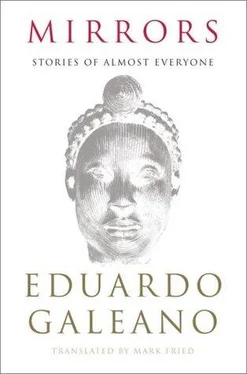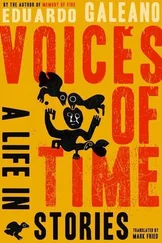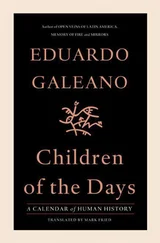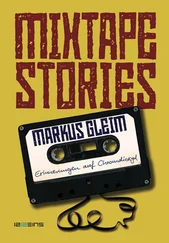Eduardo Galeano
Mirrors: Stories of Almost Everyone
No footnotes, no bibliographic sources are included.
I realized in time that they would have taken up more pages than the nearly six hundred stories themselves.
Neither have I listed the many collaborators whose assistance allowed Mirrors to become more than just a raving notion. I cannot, however, fail to mention several who had the patience to read the final manuscript and who saved me from more than a few embarrassments: Tim Chapman, Antonio Doñate, Karl Hübener, Carlos Machado, Pilar Royo, and Raquel Villagra. This book is dedicated to them and to the innumerable friends who made this impossible task possible.
Y para Helena, muy.
Montevideo, the final days of 2007
MIRRORS: STORIES OF ALMOST EVERYONE
Father, paint me the earth on my body.
— Sioux chant from South Dakota
Mirrors are filled with people.
The invisible see us.
The forgotten recall us.
When we see ourselves, we see them.
When we turn away, do they?

Life was alone, no name, no memory. It had hands, but no one to touch. It had a tongue, but no one to talk to. Life was one, and one was none.
Then desire drew his bow. The arrow of desire split life down the middle, and life was two.
When they caught sight of each other, they laughed. When they touched each other, they laughed again.

Adam and Eve were black?
The human adventure in the world began in Africa. From there, our ancestors set out to conquer the planet. Many paths led them to many destinies, and the sun took care of handing out colors from the palette.
Now the rainbow of the earth is more colorful than the rainbow of the sky. But we are all emigrants from Africa. Even the whitest of whites comes from Africa.
Maybe we refuse to acknowledge our common origins because racism causes amnesia, or because we find it unbelievable that in those days long past the entire world was our kingdom, an immense map without borders, and our legs were the only passport required.

Separate were heaven and earth, good and bad, birth and death. Day and night never mixed. Woman was woman and man was man.
But Exû, the errant bandit of Africa, liked to entertain himself by provoking outlawed minglings. And he is still at it.
His devilish tricks erase borders, join what the gods divided. Thanks to his clever deeds the sun turns black and the night burns bright. From the pores of men sprout women and women sweat men. The dying are born, the born are dying. For everything ever created or yet to be created, backward and forward get so confused you can no longer tell boss from bossed or up from down.
Later rather than sooner, divine order reestablishes its hierarchies and geographies, and everything and everyone gets put in its place. But sooner rather than later, madness reappears.
Then the gods lament that the world is such a difficult place.

Stalactites hang from the ceiling. Stalagmites grow from the floor. All are fragile crystals, born from the sweat of rocks in the depths of caves etched into the mountains by water and time.
Stalactites and stalagmites spend thousands of years reaching down or reaching up, drop by drop, searching for each other in the darkness.
It takes some of them a million years to touch.
They are in no hurry.

In school they taught me that way back in caveman times we discovered fire by rubbing stones or sticks together.
I’ve been trying ever since. I never got even a tiny spark.
My personal failure has not kept me from appreciating the favors fire did for us. It defended us from the cold and from threatening beasts. It cooked our food, lit up the night, and invited us to sit, together, at its side.

There they are, painted on the walls and ceilings of caves.
Bison, elk, bears, horses, eagles, women, men, these figures are ageless. They were born thousands upon thousands of years ago, but they are born anew every time someone looks at them.
How could our ancestor of long ago paint so delicately? How could a brute who fought wild beasts with his bare hands create images so filled with grace? How did he manage to draw those flying lines that break free of the stone and take to the air? How could he?. .
Or was it she?


In Tassili and elsewhere in the Sahara, cave paintings offer stylized images from six thousand years ago of cows, bulls, antelope, giraffes, rhinoceroses, elephants. .
Were those animals simply imagined? If not, did the inhabitants of the desert drink sand? And what did they eat? Stones?
Art tells us the desert was no desert. Its lakes resembled seas and its valleys provided plenty of pasture for the animals that would later have to migrate south in search of the lost verdure.

To be mouth or mouthful, hunter or hunted. That was the question.
We deserved scorn, or at most pity. In the hostile wilderness no one respected us, no one feared us. We were the most vulnerable beasts in the animal kingdom, terrified of night and the jungle, useless as youngsters, not much better as adults, without claws or fangs or nimble feet or keen sense of smell.
Our early history is lost in mist. It seems all we ever did was break rocks and beat each other with clubs.
But one might well ask: Weren’t we able to survive, when survival was all but impossible, because we learned to share our food and band together for defense? Would today’s me-first, do-your-own-thing civilization have lasted more than a moment?

It happens to us before birth. In our bodies as they begin to take form, something like fins appear and also a tail of sorts. These appendages don’t last; they barely show their faces before they fall off.
Do these ephemeral apparitions tell us we once were fish and once were monkeys? Fish who set out to conquer dry land? Monkeys who abandoned the jungle or who were abandoned by it?
And does the fear we feel in childhood, scared of anything, of everything, tell us we once were afraid of being eaten? Does our fear of the dark and of the anguish of solitude echo that primeval vulnerability?
Now that we’ve grown up a little, we who were fearful strike fear. The hunted is the hunter, the mouthful is now the mouth. Monsters that yesterday harried us are today our prisoners. They inhabit our zoos, adorn our flags, and embellish our anthems.
Читать дальше


















